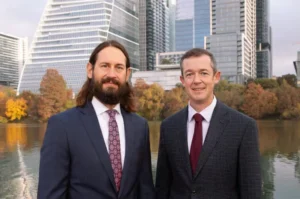 Back pain causes more lost work days than any other disease or injury. When you injure your back, you can suffer chronic pain and stiffness that limits your ability to walk, lift, or even sit comfortably. As a result, workers can participate in very few job activities while suffering from back injuries.
Back pain causes more lost work days than any other disease or injury. When you injure your back, you can suffer chronic pain and stiffness that limits your ability to walk, lift, or even sit comfortably. As a result, workers can participate in very few job activities while suffering from back injuries.
Many types of injuries can cause back pain. A car accident, for example, can strain the muscles and tendons of your back. This injury can cause temporary pain and stiffness. But the same forces can also deform your discs, producing permanent back disabilities and nerve injuries.
The Structure of Your Back
Your back includes several parts that work together to:
- Support your head and upper limbs
- Protect your organs and spinal cord
- Move your body
 The center of your back, both metaphorically and literally, is your spine. The spine has 24 vertebrae that run from your skull to your pelvis. These bones stack on top of each other to create a vertical column that supports your body. But the individual bones also articulate to allow your back to bend and twist in a way that a solid column could not.
The center of your back, both metaphorically and literally, is your spine. The spine has 24 vertebrae that run from your skull to your pelvis. These bones stack on top of each other to create a vertical column that supports your body. But the individual bones also articulate to allow your back to bend and twist in a way that a solid column could not.
Your spine includes seven cervical vertebrae in your neck, 12 thoracic vertebrae behind your chest, and five lumbar vertebrae in your lower back.
Discs sit between the vertebrae. The discs are formed from fibrous collagen surrounding gel-like collagen. Together, these materials absorb shocks when you stand, walk, and jump. They also have a smooth surface that allows the vertebrae to move without grinding.
Ligaments connect vertebrae to one another. They help the spine rebound after the vertebrae extend. They also limit its motion so you do not dislocate your vertebrae by bending or twisting too far.
The back also includes shoulder blades and ribs. These bones cooperate with your spine to support your torso and upper limbs.
The muscles of your back connect through tendons to your skull, spine, shoulder blades, ribs, and pelvis. These muscles use the leverage of your bones to carry your weight and move your upper body.
Causes of Back Injuries
Back injuries typically result from three types of trauma:
Penetrating Trauma
Penetrating trauma happens when an object pierces your back. The open wound can bleed and develop an infection. The object can also tear the soft tissues and even fracture the bones in your back.
For example, an assault with a firearm can produce incapacitating injuries as the bullet rips through muscles, breaks vertebrae, and destroys nerves and blood vessels. The bullet fragments can embed in the back, producing nerve pain and even paralysis.
Blunt Force Trauma
You experience a blunt force injury when something impacts your back without producing an open wound. Thus, you would suffer a blunt force injury in a slip and fall accident when your feet slip forward, and you fall back onto your back. Blunt force trauma can bruise soft tissues and break bones.
Hyperextension
Hyperextension injuries occur when your spine flexes, twists, or extends beyond its normal range. Flexion happens when you arch your back forward. Extension occurs when you bend backward. Twisting happens when vertebrae rotate with respect to each other. Hyperextension can stretch the ligaments, muscles, and tendons of your back.
One particular type of hyperextension is particularly harmful to your spine. During a car accident, you can experience whiplash as your body whips back and forth. This whipping motion causes your vertebrae to separate. When you come to rest, the ligaments pull the vertebrae back together, and they compress.
This cycle of hyperextension and compression can severely injure your back and neck. The hyperextension tears the soft tissues, while the compression deforms the discs.
Types of Back Injuries
Back injuries can vary in nature and severity. Some produce only temporary symptoms and will heal with treatment and therapy. Others will cause lifelong problems even after corrective surgery.
Some common back injuries include:
Back Strain
You experience back strain in an accident when the back muscles and tendons hyperextend. The hyperextension causes tears to form in the tissues, leading to symptoms such as:
- Muscle pain and weakness
- Swelling and stiffness
- Muscle spasms
With a mild strain, these symptoms will typically clear up in four to six weeks. A severe strain involving a full-thickness tear may take longer to heal. But doctors rarely operate to repair a torn back muscle or tendon.
Sprained Back
A sprained back happens when you hyperextend the ligaments between the vertebrae. When ligaments stretch too far or tear, you may experience the following:
- Joint pain in the spine
- Limited range of back motion
- Spine inflammation
- Bruises
You might also hear or feel a “pop” in your back during the accident. Like strains, sprains usually heal in roughly four to six weeks.
Bulging or Herniated Disc
Compression of your discs can cause them to deform. One type of deformation called herniation happens when the fibers of the tough outer collagen separate and allow the inner gel collagen to protrude. Another type of deformation, called bulging, occurs when the outer shell weakens and sags.
In either case, the deformed disc can press on nerves, causing symptoms such as:
- Pain that radiates into the limbs
- Numbness and tingling
- Weakness
A damaged disc will not heal, and doctors cannot repair it. Instead, they can inject anti-inflammatories into your back to reduce the symptoms of nerve compression. They can also remove the damaged disc. But surgery is usually reserved as a last resort.
Fractured Vertebra
The most dangerous back injury you can suffer is a fractured vertebra. A fractured vertebra can dislocate and sever some or all of the spinal nerves. This injury can cause permanent paralysis and loss of sensation below the fracture.
Even if your broken back does not cause paralysis, you might need several months to recover. You may need to wear a back brace or remain in traction to prevent the vertebra from slipping out of place while it heals.
Contact an Austin Personal Injury Lawyer for Help
You can pursue both economic and non-economic damages after a back injury. Economic damages include your medical costs and lost income. Non-economic damages include all the ways your injuries affected your quality of life.
Back injuries can cause chronic pain and long-term disabilities. Contact the lawyers at FVF Law by calling (512) 982-9328 to discuss your back injuries and the financial compensation you may be entitled to seek under Texas law.